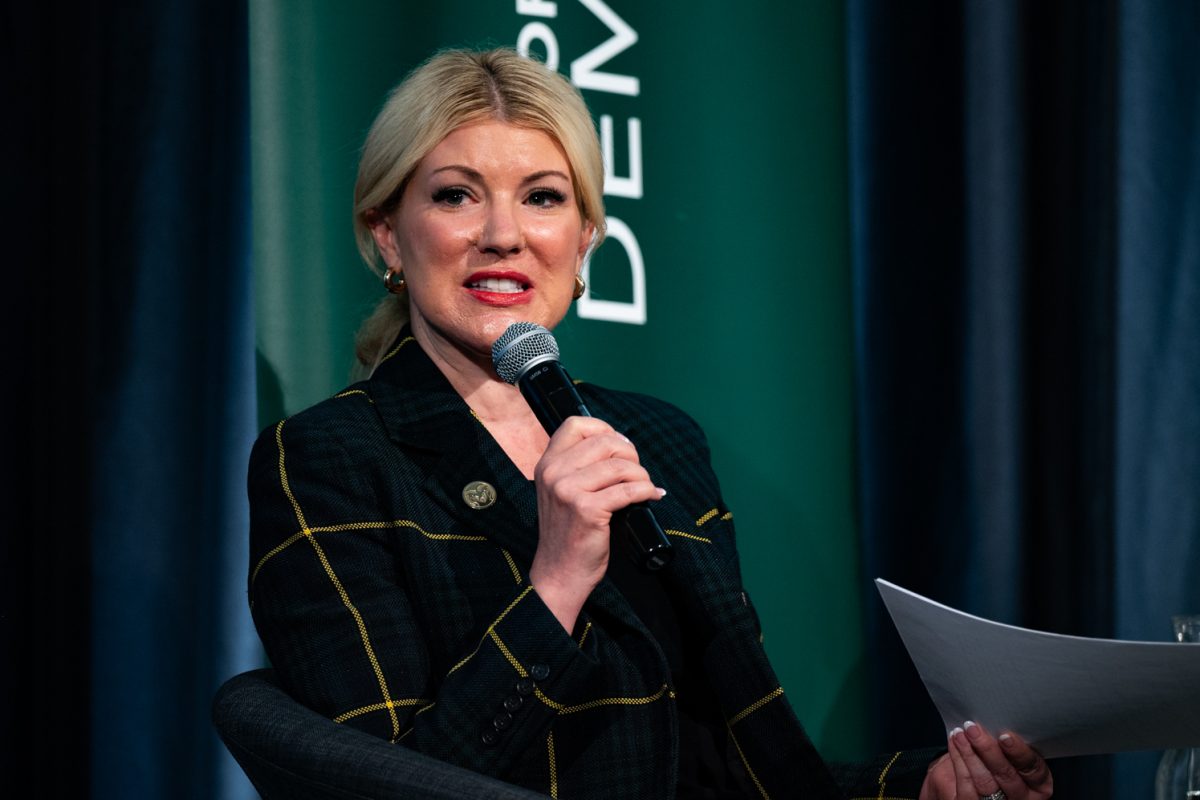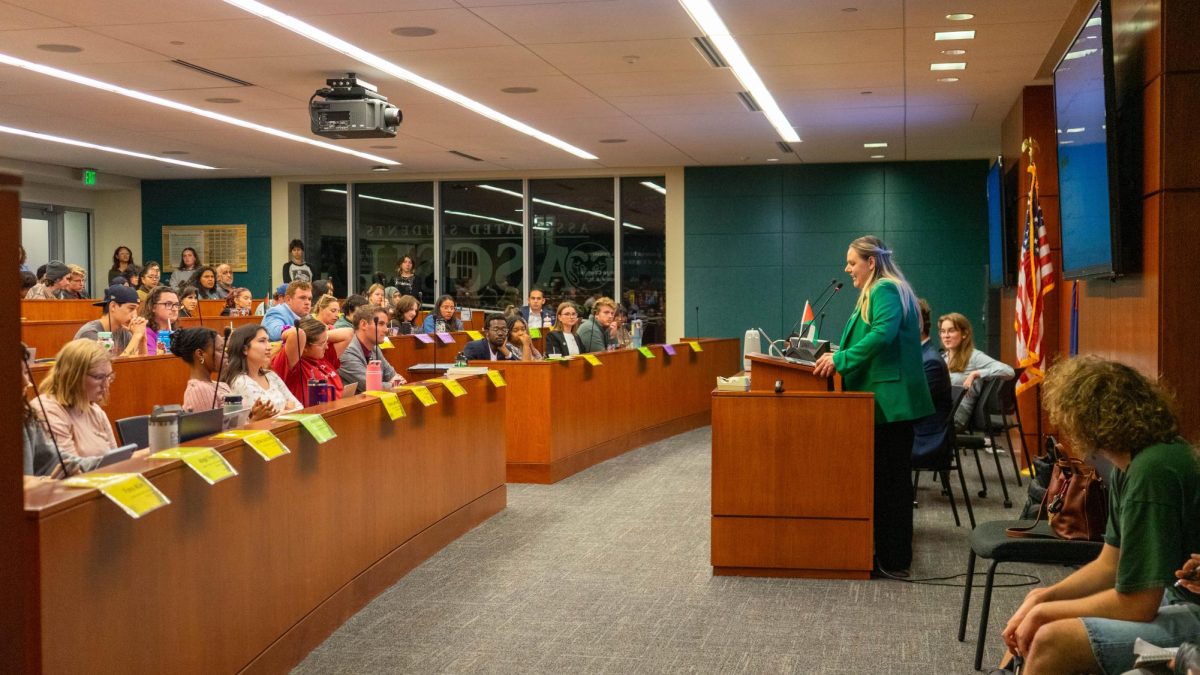Video by Sierra Cymes.
Colorado State University President Tony Frank sat down with the Collegian to discuss topics affecting CSU students: affordable housing, Hughes stadium, CSU open records, salary equity and sexual assault on campus.
This Q & A is an excerpt from a larger interview that took place Oct. 19 and has been edited for clarity.

Recently, there has been a lot of chatter about affordable housing and U + 2. Do you see a solution that can fit both the students and the city residents?
I think all of us have a role to play in it. We have launched a housing task force. This is the first time we have formally tried as a University to pull together all the different assets of the University that deal with housing.
I think, in general, you see a strong sense that maintaining neighborhoods close to campus matters, and I think all of us are supportive of that. At the same time, if you are a property owner who has a four-bedroom home, and you have parking for four people, or it’s next to campus and there’s not a need for all the people there to have cars, some of those folks have legitimate questions about why they are not able to utilize the house as it was designed. I don’t know where all of that will end up … I think ASCSU has made it clear that they want to get involved in this discussion. I think we all know that not just students, but everybody in the community, is struggling around the housing issue. That to me, is a signal that the next step is to get folks involved, sitting down, discussing things.
As we grow, and we are putting more people out into the community, there are people who believe that we are creating the stress in the housing environment in the City of Fort Collins, and therefore, we should build more dorms and keep all of the students on campus. I personally don’t think that is good policy for the University. The growth of the University’s population has been at one angle, and the growth of the city’s population has been at a much steeper one, and so, the percentage of the University as a percent of the city’s population has actually been shrinking over time.
On the other end of the spectrum, you’ve got people who will argue that CSU should stay completely out of the housing market. Somewhere between those two extremes, I think, are some opportunities. We can take land that we own, or that CSURF owns, and we can work to develop higher-density student-oriented housing that hopefully is situated in walking distance to campus or close to mass transit lines that allow us to address parking issues, address our carbon footprint, all those sorts of things.
The new stadium is very well on its way. What have and you and the other Board of Governors members discussed regarding the future of Hughes Stadium?
The Board is responsible for the land on behalf of the tax payers of the entire state, so it is a multi-million dollar financial asset for the University.
We know the stadium project has been controversial. We know that if there is a way to do something with that land that the community as a whole finds beneficial, that would be beneficial for us as well. We know there are housing challenges, does that make sense for us to potentially utilize some of that land, or to exchange that land for a piece of land that might make more sense for higher-density housing.
There have been some things written about how we ought to just donate the property to the city. I think the Board and I have been pretty clear that it is difficult to argue to the taxpayers of the rest of the state that you’re gonna take a $10 to $20 million asset and just give it away. On the other end, we do want to be thoughtful about it. There are good options to go through the visioning, we will see where that takes us in the end. I suspect that in the next few months there will be more information around it and it, and it wouldn’t surprise me if most of that work actually started to happen either this coming spring or in the fall. But, in fact, I don’t feel under a rush on it because the stadium site is not going to be available until summer of ’17 at the earliest. I think this is one of those where we want to take our time and be thoughtful and see what makes the most sense.
What incited the Board of Governors’ proposed change to the Colorado Open Records Act process?
Our General Council’s Office is probably not alone in having some frustration with the amount of time that is spent responding to open records act requests. From my part, I would tell you that I think open records act requests come in multiple flavors. There are the flavors that come from legitimate journalistic branches that want to know what happened around this topic. Then, we e have people who probably file more open records act requests than I would even have time to think up on my own.

Some of these requests are phenomenally broad. News agencies know how to phrase the requests, they are after something relatively specific, they tighten the request down to a reasonable number of people, reasonable topics, reasonable time period, and we don’t have any problem in responding to those.
I think OGC, and looking at one of their frustrations, has been looking at how do we spend less of our time on open records requests, especially these frustrating varieties. From my part, I am not in favor of restricting this, though I understand the frustration around it. I think, in general, when we are trying to demonstrate to people that we are good stewards of the public trust, and while we are putting up accountability websites and making as much information available publicly as we can, to then turn around and say, “Yeah, but there’s some stuff that we want to do in public.” I think it is a mixed-message, a wrong signal, and we are not going to pursue it.
Fort Collins City Council made all of their e-mails open to the public. Have you ever considered doing something like that?
No, I hadn’t considered it. Maybe it is a good idea. … Communication in our world is evolving and evolving very rapidly. I probably use e-mails differently than you all do. For me, it is almost as if you are having a number of simultaneous, asynchronous conversations.
There are times when I am asked to turn over e-mails and I understand that they are are all public and I am going to turn them over. But, I also understand that there are parts of those e-mails where I am talking with a friend, where it has moved outside a work setting that, there are parts of that that don’t sit real well with me.
Would I consider making all of them public at some point? Well, maybe that is the way the world is going to go. I’ll tell you right now that a lot of the communication I have with colleagues, while there is nothing secretive about it, but it is a bit like having somebody listen in on your conversations.
Can you update us on the Salary Equity Review Committee?
This committee has been looking at the senior women faculty, and (soon) we will look at the senior male faculty professors, then we will start to look at the associate professors. I assume we will get down to the assistant professors.

My hypothesis is most of our problems exist at the professor level. The latest data that I saw off of this year’s salary numbers showed that the only place we had any differences at the associate professor level; there was one department where the female associate professors were paid statistically more than the men were. We didn’t see that at the assistant professor level.
I think the data, at least in the age demographics that are at the full professor level, are pretty clear that women have not tended to be as aggressive at going out and looking at other jobs at other places. Not getting into attributing motivations, … but, because of that, that has helped create this gap, I think, at the full professor level between male and female salaries. My guess is that you are also seeing a reflection of the fact that some of these folks have been at the University 30 or 40 years; if you went back and looked at who was a department chair, we weren’t nearly as inclusive around department chairs historically as we are now. As a department chair, they get a salary increase, they go back to their role in the faculty. In some of our departments, the salary increase has stayed with them.
I think the residual of their actions over three or four decades has left us with some of these gaps. What we are trying to do now is find a way to correct as many of those gaps as we can, at least from a statistical sense. We want to do everything that we can to make sure we are fixing the problems that are there today and aren’t leaving new ones for the future.
For me, fundamentally, this is an issue of basic fairness. The idea that any of us who come in and dedicate our careers to this university and work hard, that there should be things related to our gender or any of a whole series of factors that should influence what we are paid, is just fundamentally unfair. These are things we should have addressed as a society a while ago.
The annual safety report was just sent out. The number of sexual assaults increased and the majority of those were in residence halls. Do you think the University is doing enough to support sexual assault victims specifically in resident halls?
We are clearly not doing enough because sexual assaults are still going on. We are actually a national leader in the things that we are doing. Those may sound like paradoxical responses, but I think they are both true.
This is another one of those issues, much like the gender equity salary, where it is clearly a societal issue. It cuts across every aspect of our society, and yet, I don’t think that excuses us in any way shape or form from saying, “Alright. It is a challenging problem. It is daunting, it is difficult.” People who care a lot about it have weighted into the topic and tried, and the problem is still there. The problem is driven by factors that are society-wide and beyond something that we can just say, “Ok, we are just going to stop this.” All of those things are true and none of them matter. None of them excuse us, in my way of thinking, from saying we have an absolute responsibility to do everything we can to make sure this campus is a safe as possible for every student.
You have probably heard that start to be reflected in the things that I have started to say about this topic. I think the data are really clear: Sexual violence and violence in general are male issues. OK fine, 98 percent. Once we solve that 98 percent, then I’ll worry about the other two. But, the people who can change the culture that influences how young men are brought up and how they think about these things, probably more effectively than anything else, is the peer culture of other men. It is pass time for all of us, to pretend this isn’t our issue. It is time for all of us to stand up and say, “The attitudes that have existed that have allowed this problem to fester and continue to infect our society and half our population are our attitudes.” We can, in fact, fix those. We can, in fact, change a collective expectation of how we are all going to behave.
I tend to think the recent uptick in reporting is actually a good sign because I think the incidence rate has always been that high, and what we are seeing now ar better reporting systems, a greater awareness, greater comfort level a greater understanding on behalf of women that this is not something I need to be ashamed of. I hope we are making progress in all of those areas, and if that is true, then we can expect, given these crimes are underreported to see them go up. We should also hope that the total incidence rate that is hard for us to know is coming down.
Collegian News Editor Christina Vessa can be reached online at news@collegian.com or on Twitter at @ChrissyVessa.





